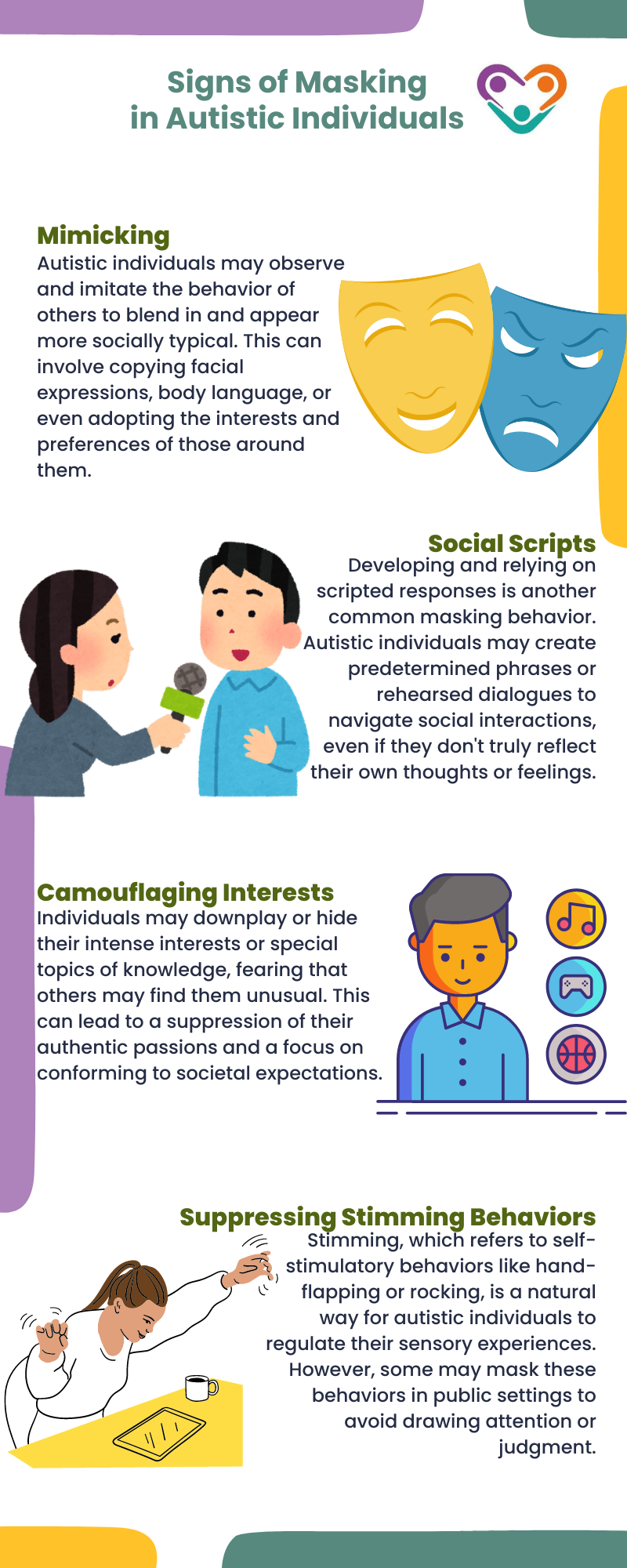One aspect that is gaining increasing attention in the context of autism is masking. But what exactly does masking entail? What are the reasons behind it, and why is it crucial in supporting individuals on the autism spectrum?
Let’s find out in this article!

What is Masking?
Autism masking, also known as autism camouflaging, refers to the process in which individuals with autism learn, practice, and perform certain behaviors while suppressing others to fit in with the people around them.
It involves adapting and conforming to social norms and expectations, often leading to the masking individual appearing to be neurotypical or not displaying obvious signs of autism.
For example, a child with autism may actively imitate the behaviors of their peers, mimicking their speech patterns, interests, and social interactions. This can make it challenging for others, including parents and caregivers, to recognize the signs of autism, as the child may seem to be getting along well and adapting to various preferences and activities.
Reasons for Masking
There are several reasons why individuals with autism may engage in masking behaviors.
Initially, children with autism may mask or camouflage their condition as a way to fit in and make life easier. They may observe that by imitating the behaviors of their neurotypical peers, they are more likely to be accepted and avoid standing out. This can provide a sense of belonging and reduce the chances of social rejection.
However, over time, the effort required for masking can take a toll on the individual’s emotional well-being. Masking involves hiding or suppressing parts of oneself to better fit in with those around them. This can lead to feelings of anxiety, anger, and unhappiness as they realize that many of their actions are performed to please others rather than out of genuine enjoyment.
Furthermore, masking can prevent individuals with autism from fully expressing their true selves and embracing their neurodivergent characteristics. The pressure to conform to societal expectations may lead to a lack of self-acceptance and a struggle to understand one’s own identity.

Impact of Masking on Individuals
Masking in autism involves the adaptation and suppression of certain behaviors to conform to social norms and expectations. While masking may initially help individuals with autism fit in, it can have significant emotional repercussions.
Here are some of its impacts:
Emotional Toll
Masking can take a toll on the emotional well-being of individuals with autism. The effort required to mask their true selves and conform to societal expectations can lead to anxiety, internal struggles, and a sense of not being true to themselves.
Over time, individuals may become aware that many of their actions are performed to please others rather than out of genuine enjoyment, which can result in unhappiness and distress.
Studies have found a significant link between masking and mental health issues. Autistic individuals who engage in masking tend to exhibit higher levels of anxiety and depression. The constant need to monitor and adjust behaviors, as well as the suppression of one’s authentic self, can be emotionally draining and prevent the development of a true identity.
This emotional distress can manifest in various ways, including anger, frustration, and a sense of being disconnected from one’s own feelings.
Social Adaptation
Masking is often viewed as a coping mechanism for individuals with autism to navigate social situations more easily. It allows them to blend in and appear more neurotypical. However, the pressure to mask can lead to an internal conflict between fitting in and expressing one’s true self.
While masking may help individuals navigate social interactions, it can hinder their ability to build authentic connections and relationships. The fear of being exposed or rejected for their true selves can create barriers to genuine social interactions.
This can lead to feelings of isolation, loneliness, and a sense of not being understood by others.
Moreover, the constant effort to mask can consume vital resources, both mentally and physically. It can be exhausting to constantly monitor and adjust behaviors, leading to what is commonly referred to as “autistic burnout.” The emotional toll of masking can contribute to mental health crises and has been associated with higher rates of anxiety, depression, and even suicidal behaviors.
Signs of Masking
Identifying the signs of masking can help uncover when an individual with autism may be camouflaging their true thoughts, feelings, and behaviors. While masking behaviors can vary from person to person, there are some common signs that you can notice.
Some of them are as follows:

High-Masking Individuals
While autistic masking is a strategy employed by many individuals on the autism spectrum to fit into a non-autistic culture, some individuals engage in high levels of masking. High-masking individuals go to great lengths to suppress their autistic traits, often at the expense of their mental and emotional well-being.
High-masking individuals with autism exhibit a range of characteristics that distinguish them from those who engage in less masking. These characteristics include:
- Suppression of autistic behaviors – High-masking individuals actively suppress their autistic behaviors, such as stimming (repetitive movements) or intense interests, in order to conform to societal expectations. They may mimic the behavior of others and develop complex social scripts to navigate social situations.
- Desire for social acceptance – High-masking individuals often have a strong desire to fit in and avoid prejudice and judgment for being different. They may go to great lengths to imitate allistic (non-autistic) social norms and hide their true selves in order to be accepted by their peers.
- Internal struggle – Balancing the need to mask their autistic traits with their authentic self can create an internal struggle for high-masking individuals. They may experience feelings of frustration, confusion, and a loss of personal identity as they navigate social situations while suppressing their true nature.
How to Address Masking in ASD
Promoting acceptance and understanding is key to addressing masking in ASD. Society needs to recognize that masking is not a choice but a coping mechanism developed by autistic individuals to navigate a world that may not always understand or accommodate their unique needs.
Creating an inclusive and accepting environment involves embracing neurodiversity and celebrating the strengths and capabilities of individuals with autism. By fostering empathy and understanding, we can encourage open dialogue, reduce stigma, and promote acceptance of individuals with ASD and their unique perspectives.
Supporting individuals who mask their neurodiversity involves providing resources and tools to help them navigate the world more comfortably. This can include consulting with psychologists, neurodevelopmental specialists, or mental health professionals specializing in ASD.
These professionals can offer guidance, coping strategies, and skills to navigate social situations while still honoring one’s authentic self.
By learning how to address masking in autistic individuals, we can create a more inclusive society that values and embraces the diversity of individuals on the autism spectrum. It is through these efforts that we can foster a world where individuals with autism feel accepted, understood, and empowered to be their true selves.
If you’re seeking specialized ABA therapy in New Jersey, Indiana, Georgia, and New York, Golden Care offers comprehensive services tailored to meet the unique needs of each individual. Contact us to learn more or book a consultation today.
Sources:
https://www.henryford.com/blog/2023/04/autism-masking
https://www.autism.org.uk/advice-and-guidance/professional-practice/autistic-masking
https://neurodivergentinsights.com/blog/what-is-masking-in-autism
https://www.theautismservice.co.uk/news/what-is-autism-masking-or-camouflaging




